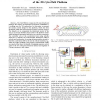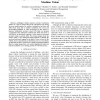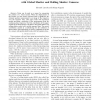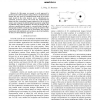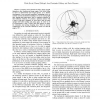IROS
2009
IEEE
14 years 6 months ago
2009
IEEE
IROS
2009
IEEE
14 years 6 months ago
2009
IEEE
— Intelligent vehicles require accurate localization relative to a map to ensure safe travel. GPS sensors are among the most useful sensors for outdoor localization, but they sti...
IROS
2009
IEEE
14 years 6 months ago
2009
IEEE
Abstract— Previous work [1] shows that the movement representation in task spaces offers many advantages for learning object-related and goal-directed movement tasks through imit...
IROS
2009
IEEE
14 years 6 months ago
2009
IEEE
— Vision can be used as a sensor for measuring the position of a visual marker. When the displacement of the marker over the camera exposure time is significant, the obtained po...
IROS
2009
IEEE
14 years 6 months ago
2009
IEEE
— In this paper we present a novel approach to perform indoor self-localization using reference omnidirectional images. We only need one omnidirectional image of the whole scene ...
IROS
2009
IEEE
14 years 6 months ago
2009
IEEE
— In nature, many animals are able to jump, upright themselves after landing and jump again. This allows them to move in unstructured and rough terrain. As a further development ...
IROS
2009
IEEE
14 years 6 months ago
2009
IEEE
IROS
2009
IEEE
14 years 6 months ago
2009
IEEE
—This paper presents a novel appearance-based technique for qualitative spatial localization. A vocabulary of visual words is built automatically, representing local features tha...
IROS
2009
IEEE
14 years 6 months ago
2009
IEEE
— When children learn to grasp a new object, they often know several possible grasping points from observing a parent’s demonstration and subsequently learn better grasps by tr...
IROS
2009
IEEE
14 years 6 months ago
2009
IEEE
— In this paper, we introduce a high-speed vision platform, H3 (Hiroshima Hyper Human) Vision, which can simultaneously process a 1024× 1024 pixel image at 1000 fps and a 256× ...
